Wigan Volunteer Light Horse
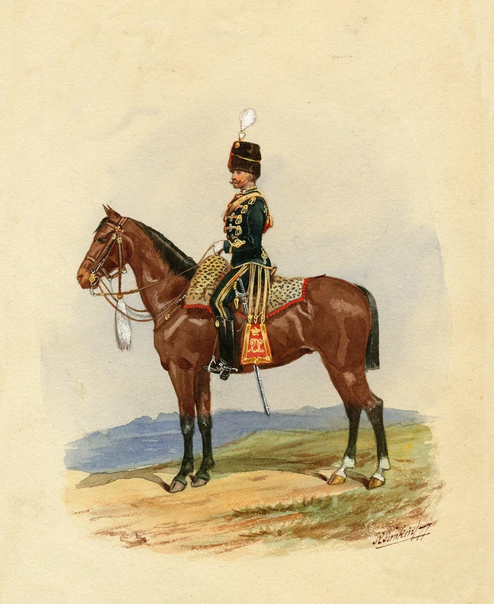
INTRODUCTION
Tracing the origins of the Wigan Volunteer Light Horse during the early part of the 19th century. The story of its evolution over the next two hundred years, detailing amalgamations, changes of role and war time campaigns, including 158 years under the cap badge of the Duke Lancaster's Own Yeomanry. Today the British Army’s modern day successor, still based in Wigan is the Queens Own Yeomanry Regiment.
PETERLOO MASSACRE
Following the end of the Napoleonic Wars in 1815 an acute economic slump occurred, accompanied by chronic unemployment and harvest failure due to the ‘Year without a Summer', and worsened by the Corn Laws, which kept the price of bread high. At that time only around eleven percent of adult males had the vote, very few of them in the industrial north, which was worst hit. Reformers identified parliamentary reform as the solution and a mass campaign in 1817 to petition parliament gained three-quarters of a million signatures, but the petition was flatly rejected by the House of Commons.
When a second slump occurred in early 1819, radical reformers sought to mobilise huge crowds to force the government to back down. The movement was particularly strong in the north-west of England, where in August 1819 the 'Manchester Patriotic Union' organised a mass rally of approximately 60,000 people in St. Peter’s Field, Manchester, addressed by well-known radical orator Henry Hunt.
Shortly after the meeting began, local magistrates called on the Manchester and Salford Yeomanry to arrest Hunt and several others on the platform with him. The Yeomanry charged into the crowd, knocking down a woman and killing a child, and finally apprehended Hunt.
Cheshire Magistrates' chairman William Hulton then summoned the 15th (The King’s) Hussars to disperse the crowd. They charged with sabres drawn and seventeen people died on the day or later of their injuries, including four women and a two year old boy. A pregnant women who had been trampled also lost her unborn child. It is estimated that 400 to 600 people were seriously injured in the ensuing confusion.
The event was first labelled the "Peterloo Massacre" by the Manchester Observer newspaper in a bitterly ironic reference to the Battle of Waterloo which had taken place four years earlier.
WIGAN VOLUNTEER LIGHT HORSE
Two months later in October 1819 a committee of Wigan factory owners, businessmen and local gentry, proposed to raise a Troop of Volunteer horsemen to safeguard the interests of the town. It was to be led by the then Mayor of Wigan, thirty four year old businessman, John Hodson Kearsley Esq. The proposal went via Lord Derby to the Home Secretary, Lord Sidmouth, and was approved by the Prince Regent, the soon to be King George III, on 20 October.
By 15 December, the Troop had mustered forty eight men with John Hodson Kearsley as Captain in Command. The other officers were his cousin, Lieutenant James Alexander Hodson, (who would be elected Wigan’s MP the following year), also Lieutenant Richard Perryn, and Cornet John Marsh (a rank equivalent to a modern day Second Lieutenant).
In 1820 the Troop paraded for exercises and drills at Southport and in October 1823 carried out Permanent Duty (Annual Camp) of eight days in Liverpool. On this occasion it was inspected by Major Watts of the North-Western Area staff and his report on their excellent turnout and discipline gave great satisfaction the new Home Secretary Sir Robert Peel. Kearsley was to stay in command of the Troop for next twenty years.
John Hodson Kearsley
As well as being a partner in the Henry Robinson Brewing Company, based in King Street, Wigan, Kearsley was a Borough Alderman sitting on various committees. He also served as Mayor of Wigan three times and Tory Member of Parliament for Wigan twice. His second in command James Alexander Hodson was also Wigan’s MP between 1820-1825.
Kearsley wasn’t exactly popular with his fellow MP’s because of his forthright manner, one describing him as that ‘vulgar little brewer from Wigan’. He was also hated by the townsfolk of Wigan as he voted against the ‘Reform Bill’ that would have ensured the reform of the corrupt electoral system. Also he voted against the ‘Cotton Mills Act’, whose aim was to improve conditions and reduce the hours that children worked in cotton mills.
He was advised to stay away from the 1831 General Election for his own personal safety after receiving threats that he would be torn from limb to limb. A mob of up to 10,000 radical protestors gathered in Market Place outside the town hall in an effort to sway the vote in their favour. Later, prominent Tories were physically assaulted and their properties ransacked when the crowd went on the rampage. It took two troops of cavalry and two companies of Infantry to quell the disturbances. Never the less the result of the Election stood and Kearsley was elected Tory Member of Parliament for Wigan.
A couple of weeks later a second attack occurred on the home of Kearsley. The door of his house in Standishgate was forced and the house ransacked, all the fixtures and fittings were ripped out and beds, chairs, tables, drawers, and bookcases were thrown onto the street, their contents including valuables, cash and silver plate strewn along the road. The property was then partly demolished and set ablaze. In the coming weeks several persons were prosecuted for handling stolen goods belonging to Kearsley, who was forced thereafter to live at his country residence of Higher Hall at Westleigh, up until his death in 1842.
LANCASHIRE YEOMANRY CAVALRY
In December 1827 the Home Secretary, the 3rd Marquis of Lansdowne decreed that all Yeomanry Units had to provide at least three troops of no fewer than 50 men each. Any not meeting these totals were either to disband or be amalgamated with other units to bring the combined unit up to strength.
This ruling by the Home Secretary meant that the days of being an independent unit were over. To avoid disbandment, in April 1828 the Wigan Volunteer Light Horse amalgamated with the Furness Troop of Yeomanry Cavalry and the Bolton Light Horse Volunteers. The title of the new regiment was to be the Lancashire Yeomanry Cavalry.
The Bolton Light Horse was the senior of the three Troops, therefore taking the lineage of the new regiment back to its formation in 1798. In 1829 the total strength of the regiment was fourteen officers and 193 other ranks. The formation of the new regiment caused much discussion and debate about the style of uniform to be worn. It is believed the Wigan Troop had a Light Dragoon uniform. The Bolton Troop had adopted a mixture of Light Dragoon and Lancer attire. The Furness Troop however considered themselves as heavy cavalry and dressed accordingly. Eventually it was decided that the uniform would be Light Dragoon pattern of blue coatee and overalls, Wellington boots and a shako helmet.
However, shortly after coming to the throne in 1830, King William IV caused dress regulations to be changed in which his personal preference for a red uniform was revealed. Accordingly all Light Dragoon regiments had to adopt a scarlet uniform with dark blue leggings and Wellington boots. However by 1840 the regiment was to adopt the heavy Roman type of helmet with plume as favoured by the heavy cavalry.
DUKE OF LANCASTER’S OWN YEOMANRY CAVALRY
The Lancashire Yeomanry Cavalry was destined to have a short existence however, for in September 1834 the Commanding Officer, Major Thomas Braddyll was called to a private audience with the King at St. James’s Palace. He was informed that the regiment was to be renamed the Duke of Lancaster’s Own Yeomanry Cavalry and Major Braddyll was to be promoted to full Colonel. (The regiment retained the title for the remainder of its existence apart from dropping the word Cavalry).
This was a great honour; the Duchy of Lancaster was founded in the 13th century and is a unique portfolio of over 44,500 acres of land, property, and assets, mainly in Lancashire and held in trust for the Sovereign in his or her role as the Duke of Lancaster. This meant that the Patron or future Honorary Colonel of the regiment would always be the Sovereign. As the Sovereign could be either King or Queen, it was decided that any badges or embellishments would consist of the Red Rose of Lancashire topped by a Ducal Coronet rather than the Monarch’s crown.
The Chartists
The regiment’s role was in aid of the Civil Power and to uphold law and order by quelling disturbances and riots (The modern army class this as Internal Security). The 1840’s were troubled times in England when Chartist disturbances erupted throughout England. So called from their ‘Peoples Charter’, and led by radical agitators, the Chartists’ basic aims were to secure universal suffrage and social equality for all. They had first presented a petition to Parliament in 1839.
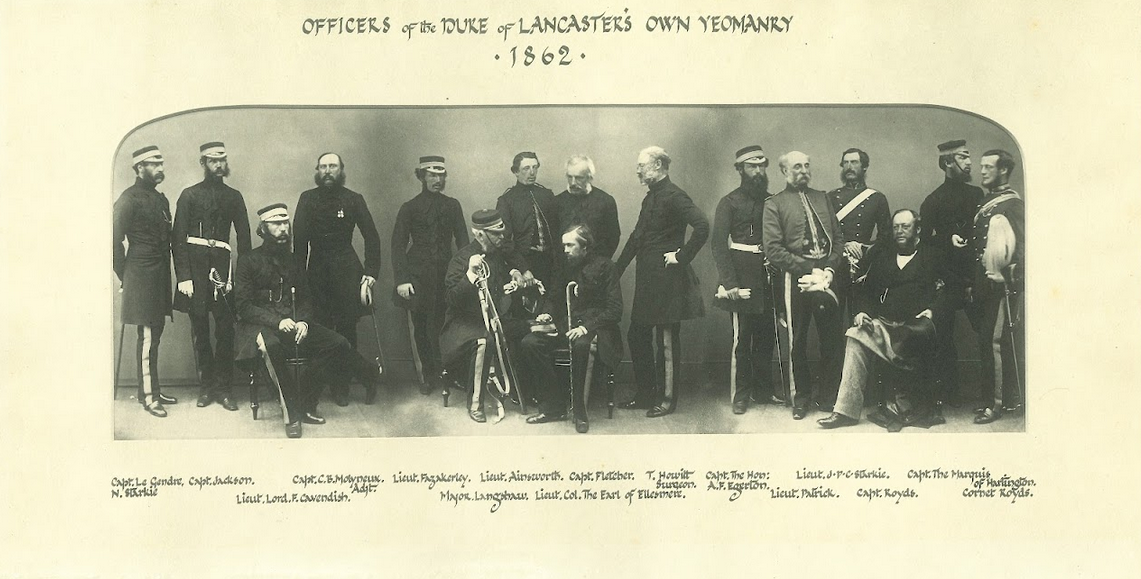
Group of DLOY Officers 1862
Resulting from rising food prices and depression in trade there was great poverty among the working classes in the Lancashire manufacturing districts. A General Strike in 1842 culminated in Chartist attacks on factories and mills in the so called ‘Plug Plot Riots’ when mobs gathered to withdraw the plugs from factory boilers and locomotives. The three Troops of the Duke of Lancaster’s Own Yeomanry (DLOY) were called out many times to disperse rioters and arrest the ringleaders who were harshly punished by the authorities.
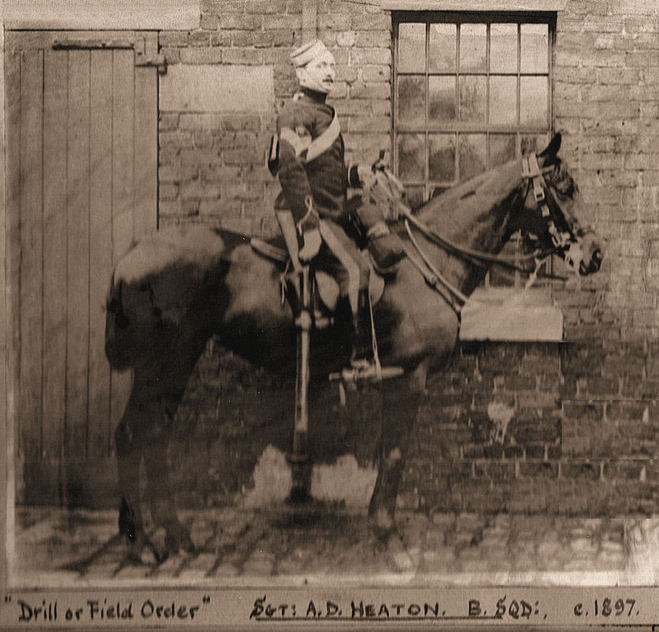
Sgt. A.D. Heaton 'B' Sqn DLOY 1897
Between 1860 and 1899 the Regular Army was involved in wars in China, South Africa, Afghanistan, Egypt, Burma, New Zealand and the North West Frontier of India. However for the home based Yeomanry regiments it was a relatively quiet time consisting of weekly drills, occasional inspections, escort duties for Royalty and Annual Camps.
BOER WAR
In 1899 the Province of Transvaal launched a force of 24,000 Boer Commandos against British held Natal in South Africa. The regular British Army could not cope with the hit and run tactics of the Boers who were a highly mobile force of expert horsemen. In December of 1899, in what was known as ‘Black Week’ the army suffered 2,000 men killed or wounded and over 800 taken prisoner.

Duke of Lancaster's Own Yeomanry (1900)
It was decided that a similar force to the Boers was needed so the Yeomanry were mobilised. Instead of keeping their original identity a numbering system was adopted, the Duke of Lancaster’s Own Yeomanry was designated as 23rd (Lancashire) Company, 8th Battalion, Imperial Yeomanry.

The 23rd Company landed in Cape Town on 4 March 1900 on board the troopship ‘Afric’ and were attached to an all arms column of infantry, artillery and engineers over a thousand strong. The Yeomen scouted ahead of the column gaining intelligence and acted as flank protection.
The regiment saw a major action on 30 May 1900 at an abandoned farmstead called Fabers Putt when the column was attacked by a force of five or six hundred Boers. The 23rd (DLOY) Company suffered six killed and twelve wounded in the battle.

Major I. Rutherford - Duke of Lancaster's Own Yeomanry (1900)
The next twelve months was spent patrolling and skirmishing with the elusive Boers and enacting a scorched earth policy in which farmsteads were burnt to the ground in order to deny aid to the Boers from sympathetic farmers.
The first contingent of DLOY returned home in May 1901. In 14 months campaigning they had ridden over 5,000 miles. In 1901 a second contingent was sent out to Africa, suffering four killed in action and six wounded.
In the two year campaign the DLOY lost eleven killed, 25 wounded, pus six died of fever. They were awarded three Distinguished Conduct Medals, two Distinguished Service Orders and five Mentioned in Dispatches.
The Territorial Force
The Army Reserve underwent a major restructuring in 1908 in the reforms introduced by Richard Haldane, the Secretary of State for War. The previously civilian-administered 'Volunteer Force' was combined with the mounted Yeomanry, while the Militia was renamed the 'Special Reserve'.
WORLD WAR ONE
When WW1 began in 1914 ‘Headquarters Squadron' and ‘C’ Squadron were based at Clifton near Manchester, ‘A’ Squadron at Oldham and Rochdale, ‘B’ Squadron at Bolton and Liverpool and ‘D’ Squadron at Preston and Blackpool. An army order was issued decreeing that all Yeomanry regiments deployed no more than three Sabre Squadrons. Since ‘B’ Squadron was the weakest it was broken up and its members dispersed among the other Squadrons.
‘A’ Squadron in the Middle East
‘A’ Squadron was the first of the DLOY Squadrons to deploy when as divisional cavalry for the East Lancashire Division they sailed for Egypt in September 1914. The East Lancs Division was the first ever Territorial Division to leave Britain’s shores on active service.
Their role was to protect the Suez Canal against Turkish aggression. In 1915 the division took part in the Gallipoli campaign but ‘A’ Squadron remained in Egypt as the terrain on the rocky peninsula excluded the use of cavalry. Whilst in Gallipoli the East Lancashire Division was re-designated as 42nd Division. They returned to Egypt in January 1916 and continued their role as part of the Suez Canal Defence Force.
When 42nd Division was ordered to the Western Front in France in 1917. ‘A’ Squadron remained behind in Egypt to become divisional cavalry for the incoming 53rd (Welsh) Division, then later the 60th (London) Division.
‘A’ Squadron spent the whole of the war in the Middle East as mounted cavalry and rode many hundreds of miles. They took part in the Sinai and Palestine campaigns, witnessing the capture of Gaza, Beersheba, the Holy City of Jerusalem and Haifa.
On 30 September, XXI Corps Cavalry Regiment formed an independent 'Cavalry Group with the Light Armoured Car Battery and the 1/8th Gurkha Rifles, tasked with advancing along the coast to Beirut. With 'A' Squadron in advance Beirut was reached on 8 October without opposition.
On 26 October the 5th Cavalry Division entered Aleppo unopposed, the Turkish High Command sued for peace and on 1 November 1918 the Armistice was signed. With the war in the Middle East at an end 'A' Squadron were withdrawn to Beirut to await repatriation. Despite arduous campaigning from 1914 to 1918 ‘A’ Squadron suffered relatively light casualties, losing just 18 dead. They were awarded two Distinguished Conduct Medals, three Military Medals, two Mentioned in Dispatches and one Croix de Guerre. In addition an attached officer from the Bedfordshire Yeomanry gained the Military Cross.
A total of 23 Battle Honours were granted to complete regiments or battalions which fought in Egypt and Palestine. Because the DLOY contingent was a single squadron separated from their Headquarters, the War Office Committee denied them any Battle Honours. ‘A’ Squadron had nothing to show for four years of arduous campaigning.
HQ,‘C’ & ‘D’ Squadrons in France & Flanders
When ‘A’ Squadron sailed to the Middle East, ‘HQ,’ ‘C’, and ‘D’ Squadrons moved to Crowborough in Sussex. As divisional cavalry for the 14th Division 'D' Squadron disembarked at Le Havre on 23 May 1915. ‘C’ Squadron and ‘HQ’ followed suit disembarking on 28 August as divisional cavalry for the 23rd Division.
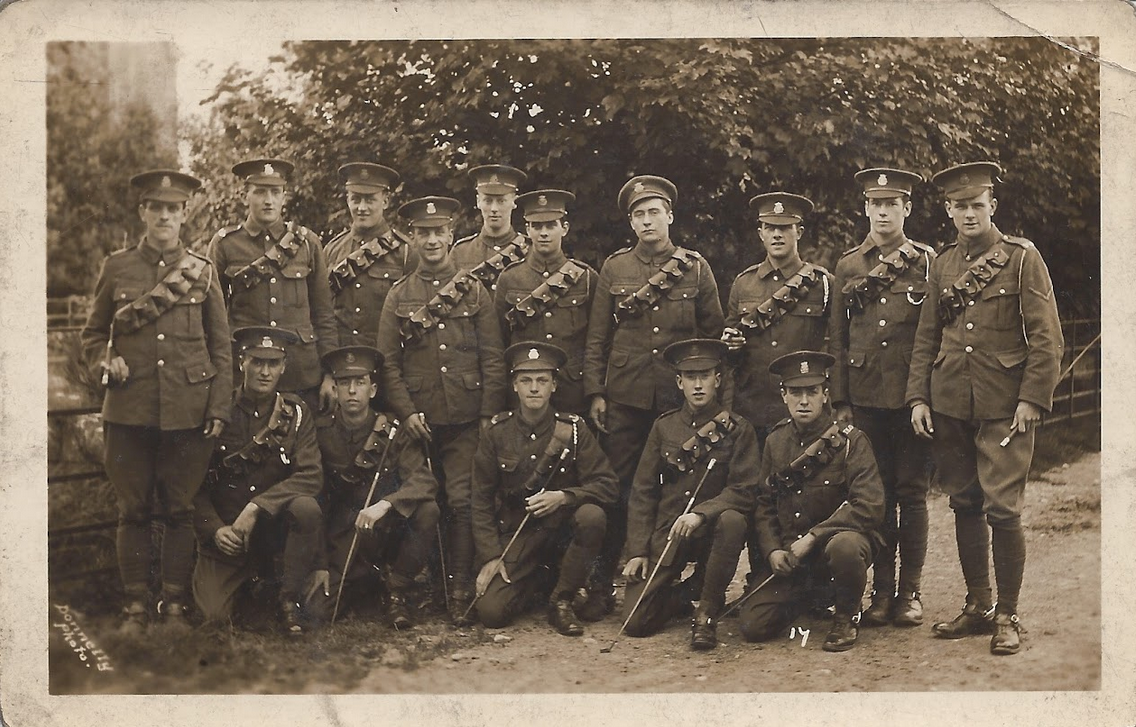
Duke of Lancaster's Own Yeomanry (1915)
It was soon realised that there was no place for mounted cavalry on the modern battlefield, so for the next 12 months the Yeomanry regiments found themselves as dogs bodies doing mundane jobs such as prisoner escort, dugout construction, entrenching and work details.
They were also committed to doing spells in the trenches. At first selected officers were sent to do a week’s tour of duty on the front line to familiarise themselves with the routine. 'C' Squadron then sent successive parties of two officers and 50 men on attachment to the 9th Battalion Yorkshire Regiment in the Bois Grenier area, south of Armentieres.
On 14 May 1916 the three DLOY squadrons were reunited at a base camp near Boulogne. Here 'C' Squadron Surrey Yeomanry joined them to form III Corps Cavalry Regiment. On 1 July, the first day of the Battle of the Somme, 63 men of the regiment, armed with six Hotchkiss machine guns manned a support trench at La Boiselle, just to the north of the strategic town of Albert. That night they were joined by 87 men of the Lincolnshire Regiment, survivors of the mornings initial attack. After four days and nights in the trenches the III Corps Cavalry Regiment was pulled back to Dernacourt.
On 27 June 1917 the DLOY learned that they were to be re-roled as infantry soldiers and withdrawn to the Base Depot at Beaucourt for a course of intensive infantry training. In August 1917, the first draft of 132 men from ‘C’ & ‘D’ Squadrons joined the 12th (Service) Battalion Manchester Regiment, part of 52nd Infantry Brigade of the 17th (Northern) Division. They had suffered heavy casualties in the Ypres Salient and were refitting behind the lines at Hauteville. The Battalion was then renamed the 12th (Duke of Lancaster’s Own Yeomanry) Battalion, Manchester Regiment.
On 9th November the 12th (DLOY) Battalion were brought out of reserve to join the latter stages of the Battle of Passchendaele, relieving the 6th Northumberland Fusiliers in the line near the Turenne crossing. 'C' Company bore the brunt of the action. In two days they suffered 16 killed in action, 49 wounded, and 17 missing believe killed.
During the Battle of Cambrai fought between 20 November and 4 December 1917 the regiment was in support trenches south of Flesquires and suffered no casualties.
January 1918 found them in defensive positions holding the line between Havrincourt and Flesquieres. In February they were eventually relieved and moved into Divisional Reserve at Havrincourt on the Somme for a much needed rest and refit.
On 21 March 1918 the Germans launched their Spring Offensive, retaking ground they had lost in 1916-1917. Reinforced by nearly 50 Divisions transferred from the Eastern Front, they hoped to defeat the British Army before the newly arrived Americans could make an impact in the Allies favour.
Back in the line at Havrincourt 12th Battalion protected the right flank after a German breakthrough and fought off repeated attacks. After being in constant action for three days the men were exhausted, running low on ammunition and with casualties mounting the 52nd Brigade was withdrawn to Flers.
There then followed a series of moves and actions to plug gaps in the line, and by 31 March the Brigade was concentrated around Albert. In ten days fighting the Battalion suffered 18 killed in action, 108 wounded and 110 missing or taken as Prisoners of War.
By July the German Offensive had petered out and with the American Army now combat ready the Allies were ready to go on the offensive. On 8 August they launched the '100 Days Offensive', a series of massed Allied offensives that led to ultimate victory.
In October 1918 the Allies drove the Germans back beyond the Hindenburg Line. The 12th Battalion saw action at the crossing of the River Selle when they unsuccessfully attacked the village of Neuville. In a costly days fighting the Battalion suffered 280 killed, wounded or captured.
The Battalions last action of any consequence occurred on 4 November when along with the 10th Battalion Lancashire Fusiliers and 9th Battalion Duke if Wellington's Regiment they successfully attacked Mormal Wood but in doing so lost six officers and over a hundred other ranks.
By 10 November 52nd Brigade had reached Beaufort. The next day at 11am the Armistice came into effect and the Great War was finally over, but It wasn't until 19 April 1919 that the remnants of the DLOY Battalion were finally demobilised and returned home via Southampton. The Great War cost the 12th Battalion 2834 casualties. The Duke of Lancaster's Own Yeomanry lost nine officers and 119 other ranks. Also 42 other ranks fell whilst serving with other battalions between June 1917 and November 1918.
Military Decorations awarded to the DLOY included two Distinguished Service Orders, four Military Crosses, four Distinguished Conduct Medals, eleven Military Medals, one French Croix de Guerre, one Belgian Croix de Guerre and an Italian Medal for Military Valour.
THE INTER WAR YEARS
Following the end of the Great War the Territorial Force was placed in suspended animation pending decisions on its future role and organisation. In 1921 the Duke of Lancaster’s Own Yeomanry and the Lancashire Hussars were amalgamated to form 2nd (Lancashire Yeomanry) Army Brigade, Royal Artillery.
However before the new artillery brigade was equipped and established the War Office had a change of heart. The DLOY artillery batteries were to be disbanded and reconstituted as a mounted Yeomanry regiment in their own right. The regiments role was exactly as in 1914, Divisional Cavalry for the 42nd (East Lancashire) Division.
In the early 1920’s, in recognition of ‘A’ Squadron’s service in the Middle East and in lieu of Battle Honours the DLOY were given the unique distinction of wearing chain mail on their service dress. (today’s No 2 khaki Dress). The only unit in the British Army permitted to do so. During the inter-war years the regiment reverted back to peacetime part-time soldiering with weekly drill nights and fortnightly annual training camps at various locations around the country.
The DLOY sent seven senior ranks to represent the regiment at the State Funeral of King George V In January 1936. After lying in state at Westminster Abbey the King was buried in St. George’s Chapel, Windsor. In July 1939, the regiment came back from annual training at Garndale Camp, near Catterick not knowing that within a few weeks war would be declared which would engulf the world and lead to millions of deaths.
WORLD WAR TWO
At the start of WW2 the DLOY were still roled as mounted cavalry, but in November 1939 the regiment became a mechanized unit of the Royal Artillery. They had a choice of an anti-tank role, field guns or medium guns. The Medium Gunner role was chosen and the Squadrons reformed into ‘A’ and ‘B’ Batteries.
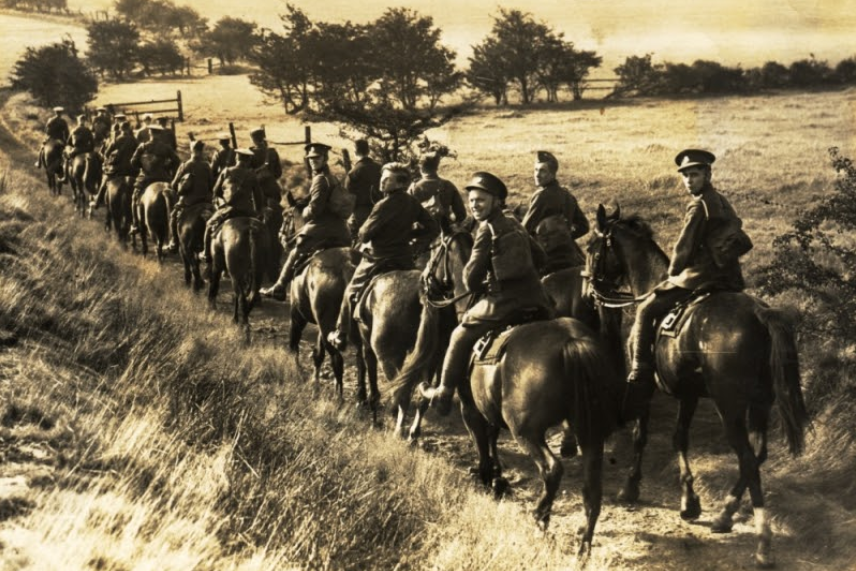
Troopers of the Duke of Lancaster's Own Yeomanry (1939)
The regiment was posted to Pembroke in South Wales and whilst there was split into two distinct regiments. The former ‘A’ Battery became 77th Medium Regiment Royal Artillery and ‘B’ Battery became 78th Medium Regiment Royal Artillery.
August and September of 1940 saw bombing raids on nearby Pembroke Dock and a bomb falling near the 77th's Officers' Mess resulted in one soldier being killed, the first wartime casualty of the DLOY. In October 1942 the DLOY regiments were equipped with 5.5 inch Howitzers which could fire a shell nine miles.
78th (DLOY) Medium Regiment Royal Artillery
On 15 Jan 1943 the 78th embarked at Liverpool for Alexandria in Egypt and re-designated as 105 and 106 Batteries. Finally after four years training and kicking their heels in the UK they shipped out of Egypt in November 1943, disembarking at Taranto on the heel of Italy to enter the Italian theatre of operations.
On 1 Jan 1944, the 5.5’s of 78th Regiment went into action against the enemy for the first time, against targets at Orsogna and Guardiagrele. In March they were attached to the 5th U.S. Army. With the failure of the Anzio Landings the 5th U.S. and 8th British Armies attacked the Gustav Line in an effort to capture Rome.
Some 70 miles south of the capital stood the German strong-point of Monte Cassino towering 1,700 feet above the Liri and Rapido valleys. It had held out for over three months against constant artillery bombardments and aerial attacks. The 78th moved into the Cassino area by the end of March. On 11 May 1944, under the command of the British 4th Division, they were part of the offensive to capture Monte Cassino when 1,600 guns opened up simultaneously.
The next day, 12 May, No. A4 Gun Pit received a direct hit, killing all the gun crew immediately, apart from Sgt. Williams, the Gun No. 1 who was blown clear and survived with minor injuries. By chance the Regiment's second in Command, Major D.W Seddon-Brown, along with Lieutenant L..H Straker, on attachment from the South African Artillery and Battery Sgt. Major J.C Turner were visiting the gun, they were all killed outright. (They now all lie in Cassino War Cemetery at the foot of Monte Cassino).
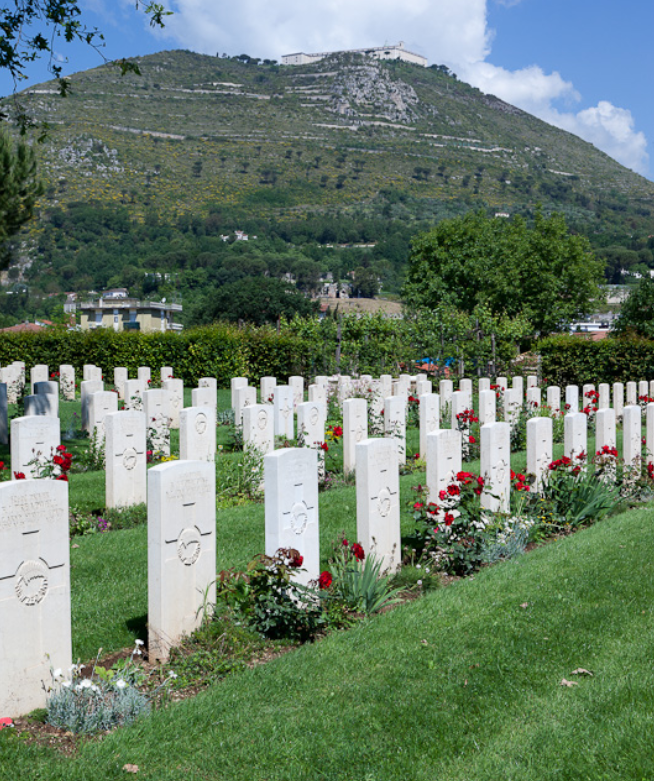
Cassino War Cemetery, Italy with Monastery in background
On 25 May Monte Cassino finally fell. The Allies then advanced up the Apennine mountain range to attack the strongly defended Gothic Line, just north of Florence, stretching from La Spezia on Italy's west coast to Rimini on the Adriatic. the 78th were almost in continual action laying down defensive fire and supporting infantry attacks. On 28 July they fired 200 rounds in support of The Royal West Kents who attacked a strongpoint just south of Florence. A few days later they were aiding a Gurkha battalion assaulting a mountainous position.
After the fall of Florence on 11 August the 78th were transferred to the 1st British Infantry Division. From November 1944 to April 1945 the campaign remained bogged down but the 5.5's of the 78th remained constantly in action with harassing and counter battery tasks and the occasional opportunity target.
The 78th were in Padua when the war ended, they were then assigned to the Trieste area on the Slovenian border. Here they formed a mounted police troop, working with the Italians to maintain law and order. In January 1946 the troop became known as 78 Regiment (DLOY) Auxiliary Police. They were disbanded three months later in April 1946. In WW2 the Regiment had suffered 33 killed in action.
The Cheshire Yeomanry can rightly claim that they were the last regiment to fight on horseback but the Duke of Lancaster’s Own Yeomanry can also claim that they were the last regiment to serve overseas in a mounted role.
77th (DLOY) Medium Regiment Royal Artillery
In November 1940, the 77th moved from Pembroke to County Armagh in Northern Ireland. In 1943 they moved to Knaresborough in Yorkshire and by May 1944 they were in Aldershot in preparation for Operation Overlord, the Normandy Landings. On 13 June they sailed from Tilbury Docks and landed on the Normandy coast on D-Day plus 9 between Courseulles and St. Aubin.
In July the guns were in continuous action firing in support of Operation Goodwood, the breakout from the beach head onto the Falaise Plain, in twelve hours the two batteries fired 3,412 rounds. In August they then fired concentration after concentration into the Falaise Pocket from which the German 7th Army were trying to extricate themselves.
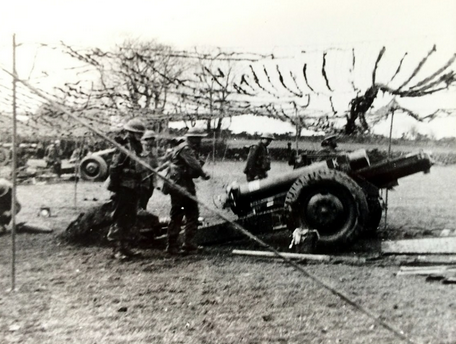
77th (DLOY) Medium Regiment Royal Artillery - WW2
After 46 days of continuous action the regiment was withdrawn to the Bayeux area for a much needed rest and refit. With the Battle of Normandy over the 77th then followed the advancing armies through liberated France and Belgium into Holland where on 21 September they supported 159 Brigade in the crossing of the Wilhelmina Canal.
During October and November the regiment was engaged mainly on counter battery shoots, but also the destruction of enemy observation posts in church steeples across the River Maas.
By 1 December the two batteries were in position at Sevenum, near the city of Venlo, the next objective of the 15th (Scottish) Division. By early March 1945 the Germans had been driven back across the River Rhine. On 16 March the 77th, after a spell out of the line in Belgium moved up to a concentration area opposite Wesel, where the whole of 21st Army Group artillery was preparing to fire in support of Operation Plunder, the Rhine Crossing.
On the morning of 23 March all 2,000 guns opened up with a preliminary bombardment, followed by hundreds of bombers and an airborne assault. The 77th supported the 1st Commando Brigade in the assault and by nightfall of the next day the bridgehead over the Rhine had been secured.
The regiment then came under the command of the 6th Guards Armoured Brigade whose next objective was the city of Munster. The Guards seized the bridges over the Dortmund-Ems Canal but before an assault could begin on 2 April the Burger Meister was persuaded to surrender the already devastated city without further fight. The 77th moved into a vacated German barracks in the north-western suburbs.
A move to the already captured City of Osnabruck followed. Here their guns were taken out of action and for the next three weeks they were detailed to assist the British Military Governor in administering the thousands of Displaced Persons, guarding German prisoners and mounting guards and patrols to preserve law and order in the town.
The 77th fired their final rounds of the war on 28 April 1945 when they fired a concentration to clear the forest of Sachsen Wald in support of 15th Scottish) Division.
On 8 May, 'Victory in Europe Day', the regiment was ordered to occupy former German barracks at Rendsburg on the Kiel Canal, about twenty miles to the west of Kiel on the Baltic Coast.
Along with other units of 8th Army Group Royal Artillery they shared responsibility for some 1,800 square miles of territory, with its thousands of displaced persons and released prisoners of war of many nationalities. Also guards had to be found for key buildings and installations, as well as hunting down and arresting members of the SS and Gestapo.
In eleven months the Regiment had driven 900 miles and fired thousands of rounds of high explosives, losing seven officers and 38 other ranks. They were awarded three Distinguished Service Orders, nine Military Crosses, two Military Medals and one OBE.
A famous member of the DLOY was actor Arthur Lowe who played 'Capt Mainwaring' in Dad’s Army. He joined the DLOY in 1938 and was with the 77th in Pembroke and Northern Ireland before re-badging to the Royal Electrical & Mechanical Engineers, where he served in the Middle East, eventually becoming a Sgt Major.
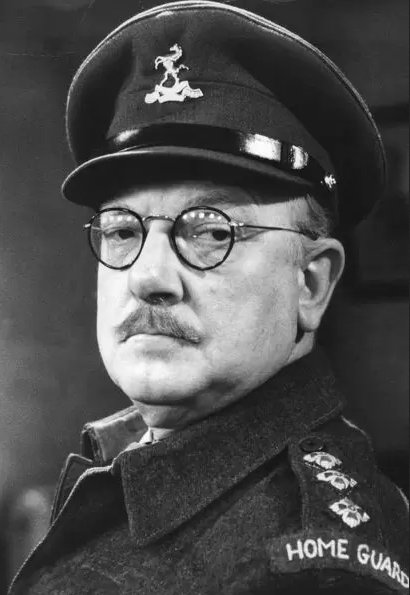
Arthur Lowe
POST WAR
In early 1946 the Yeomanry was put into suspended animation but on 1 Jan 1947 fifty Yeomanry regiments were reformed. The DLOY became members of the Royal Armoured Corps in the reconnaissance role, equipped with Landrovers and Daimler Armoured Cars, later replaced with Ferret Armoured Cars. The regiment formed an affiliation with the regular army regiment the 14th/20th Kings Hussars who recruited in the Lancashire area, this association between Regular and Territorial Unit was to last fifty five years.
In January 1956 the War Office in consultation with the Battles Nomenclature Committee issued their recommendations for Second World War Battle Honours. All units of Yeomanry and infantry regiments that had converted to the Royal Artillery during the war and since reverted to their original status were to be awarded an Honorary Distinction in the form of a Badge in lieu of Battle Honours.
Just as in the First World War the DLOY had once again been deprived of Battle Honours, this time as a result of re-badging to the Royal Artillery. The Royal Artillery have been involved in almost every battle and operation the Army has fought in its 300 year history. They are not granted battle honours, instead they have the motto 'Ubique' which means 'everywhere' and they consider their guns to be their colours.
By tradition cavalry regiments display their battle honours on a Guidon, which is a swallow tailed banner, as opposed to the rectangular shaped flag, known as a 'Colour' used by infantry regiments.

Guidon of Duke of Lancaster's Own Yeomanry
Despite appeals by the Honorary Colonel Dennis Bates and correspondence over a three month period to the Under Secretary of State at the War Office, the decision was final. Today all the regiment has to display on the Regimental Guidon for its service in the Italian and North-West Europe campaigns is the Honorary Distinction of a small ‘Gun’ Badge of the Royal Artillery with the dates ‘1944-1945’ and two scrolls, ‘North West Europe’ and ‘Italy’.
On 24 May 1961 Her Majesty the Queen, accompanied by the Duke of Edinburgh presented a new Guidon to the regiment at Belle Vue Stadium, Manchester. It was over half a century before that the Queens grandfather King Edward VII had presented the previous Guidon to the regiment at Worsley Park in 1909.
In 1966 the new Labour Government had made radical changes to the Territorial Army (TA) which came into effect in 1967. The TA became known as the Territorial Army & Volunteer Reserve (T&AVR) and the establishment was greatly reduced.
In order to avoid disbandment the DLOY amalgamated with 40th/41st Royal Tank Regiment (TA). As for the uniform it was agreed that the DLOY cap badge would be retained, the collar badges would be Royal Tank Regiment and a cloth tank badge would be worn on the right shoulder. It was at this time that the regimental band which had been an integral part of the regiment was disbanded, never to be reformed.
More unwelcome news followed, on 16 January 1968 the government announced that financial support was to be withdrawn for all Yeomanry regiments reserved for Home Defence. This meant that unless they could finance themselves there would be no alternative but to disband.
The then Commanding Officer of DLOY (RTR) Lt. Col. Norman Phillips was determined that the regiment would survive. He lobbied the MP’s for the North West constituencies, with their help and funds from the T&AVR Association a four-day camp was held at Weeton Camp near Blackpool. Facilities were provided by the 5th Royal Inniskilling Dragoon Guards and Landrovers were borrowed from the Cheshire Yeomanry. At this point the strength of the regiment was down to twenty officers and 75 other ranks.
However the worst was yet to come, in April 1969 the CO learned that all the Yeomanry regiments of the T&AVR Home Defence Force were to be reduced to cadres of eight all ranks. The DLOY Cadre, based in the old HQ at Clifton near Manchester would consist of two Officers, one Warrant Officer, two Sergeants and three Lance Corporals. In total seventeen regiments had been slashed to eight strong cadres: the only full-strength regiment remaining was the Royal Yeomanry formed from the amalgamation of five other Yeomanry regiments in 1967.
Still, Lt. Col Phillips was determined to continue regardless. In June of that year the Cadre managed a two-week attachment to the 9th/12th Lancers at Catterick for training in tank driving and gunnery. In 1970 Colonel Phillips persuaded the 75th Royal Engineers (TA) to transport the cadre to Germany for their annual camp. The first week was spent with their affiliated regiment, the 14th/20th Kings Hussars at Paderborn. They then moved to Hameln to train with the 75th RE, whom they assisted with radio communications, part of the deal for the free transport to Germany.
REPRIEVE
On 19 June 1970, the Labour Party was defeated at the General Election by the Conservatives and their promise to resurrect the Territorial Army soon materialized. The cadres of ten Yeomanry regiments were to be expanded into full squadrons and merged into three new regiments, titled the Queens Own Yeomanry, The Wessex Yeomanry, and the Mercian Yeomanry. These being in addition to the existing Royal Yeomanry.
In February 1971, the DLOY Cadre was given the option of joining one of these regiments or reforming as a distinct DLOY Regiment, but in a Home Defence role as dismounted Yeomanry. After consultation with the Honorary Colonel it was decided to choose the latter. The Duke of Lancaster’s Own Yeomanry (DLOY) had been saved from extinction.
So on 1 April 1971 the Duke of Lancaster’s Own Yeomanry was reformed again as a full regiment, the only Yeomanry regiment to exist under its original title. It was soon recruited up to strength with 12 officers and 232 other ranks.

Volunteer Drill Hall, Powell St, Wigan (demolished 1986)
HQ remained at Clifton, ‘A’ Squadron moved into the Volunteer Drill Hall in Powell St, Wigan, ‘B’ Squadron were based in Chorley, and ‘D’ Squadron at Preston. (‘C’ Squadron had been disbanded). They would now operate as infantry in the dismounted role. In 1981, in order to be central to its recruiting area HQ Squadron moved from Clifton to Chorley, with ‘B’ Squadron moving the other way to Clifton. At the same time ‘D’ Squadron detached a troop to Talbot Road in Blackpool.
In June 1977 members of the regiment experienced their first spell of overseas training when 120 all ranks joined up with the 4th Battalion, The King’s Own Royal Border Regiment for an annual Territorial exercise on Gibraltar. This gave the resident infantry unit the 2nd Battalion Royal Green Jackets an opportunity to return to the UK for specialised training before a tour of Northern Ireland. The regiment returned to Gibraltar for a second time in 1980 to relieve the 2nd Battalion Light Infantry on border Duties.
The same year the DLOY provided a Guard of Honour outside Wigan North Western railway station in Wallgate on the occasion of the visit to Wigan by Her Majesty the Queen on her Silver Jubilee tour of the country.
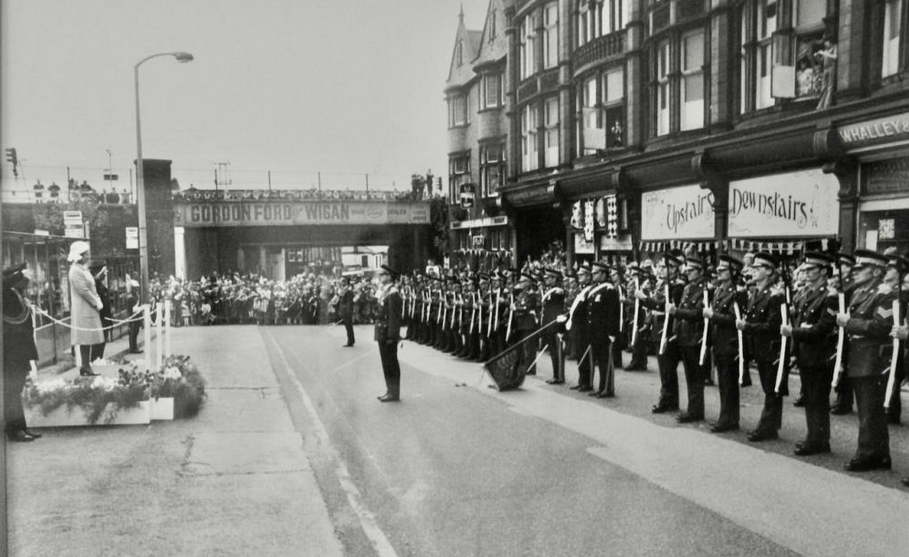
Royal Guard of Honour in Wallgate, Wigan (1977)
In 1983 the DLOY was once again re-rolled, to that of a Home Defence reconnaissance regiment, tasked with covering the whole of the North of England and Scotland.
‘A’ Sqn at Wigan was tasked with becoming the reconnaissance unit for the Highland and Islands of Scotland. Key installations and their associated supply depots included three RAF Bases, RAF Leuchars, just south of Dundee in Fife who were equipped initially with Phantom aircraft then Tornadoes. RAF Lossiemouth on the Moray Firth who flew Buccaneers then Tornadoes and nearby RAF Kinloss who belonged to Coastal Command and flew the Nimrod aircraft. Also the naval base at Rosyth just north of Edinburgh and the nuclear submarine base at Faslane on the River Clyde near Glasgow.
Ever adaptable, the DLOY had existed as horsed cavalry and infantry in WW1, medium artillery in WW2, tankies for a short spell, infantry again, and now light reconnaissance.
The DLOY featured in an article in the Soldier magazine in 1984 in which the following interesting facts were quoted. For the twelve month period up to July 1984 the Squadron’s vehicles had driven a total of 238,461 miles. Recruiting had been very selective, out of 212 applicants, only 131 were finally accepted. The remainder had been rejected on medical grounds or for criminal convictions etc.

H.M the Queen takes the salute at Altcar near Southport (1985) (Author on right)
In June 1985, Her Majesty the Queen visited the north west and spent a day with the regiment at Altcar Training Camp near Southport. The same year members of the Regiment’s Ceremonial Guard were awarded the honour of guarding the trophies for the Grand National at Aintree. A tradition that still continues to this day.
In 1986 the old Volunteer Drill Hall in Powell Street, which dated from 1884 was demolished to make way for a new road improvement scheme. The DLOY moved into temporary premises in Woodhouse Lane until a new purpose built Drill Hall could be completed.
The following year a composite Squadron commanded by Major J. Tustin headed off to Gibraltar again on border Duties, the third time the regiment had taken part in Exercise Marble Tor.
A New Home
The new Drill Hall in Canal Street, off Woodhouse Lane in Wigan was officially opened on 21 October 1989 by Sir David Ramsbottom KCB, CBE, Inspector General of the Territorial Army. It was named Kearsley House after the founder of the Wigan Volunteer Light Horse, John Hodson Kearsley. The premises are shared by the Kings Royal Hussars and Grenadier Guards detachments of the Army Cadet Force and 723 Squadron Air Training Corps.
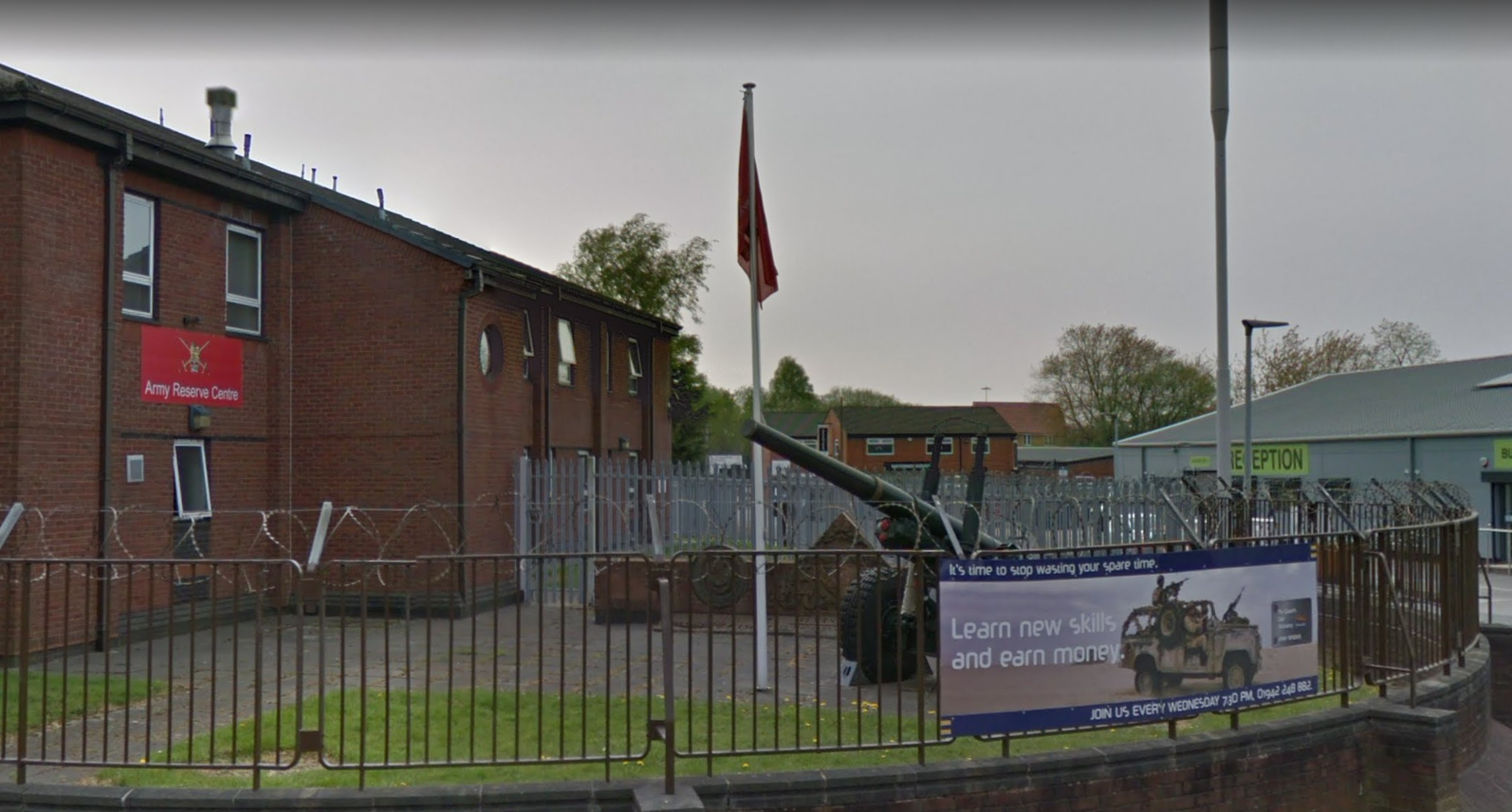
Army Reserve Centre, Canal St, Wigan
It is tradition that military establishments have gate guards, typically armoured vehicles, artillery pieces, weapons' systems, or in the case of the RAF, aircraft. Originally the gate guard at Canal Street was a Ferret Scout Car but this was later replaced by a 5.5inch Howitzer, which was transported from Fulwood Barracks in Preston. It is the same type of gun manned by the DLOY during World War 2. Also on display is a section of brickwork depicting the badge of the Lancashire Rifle Volunteers, saved when the old Volunteer Drill Hall in Powell Street was demolished.
On 18 October 1990, the regiment was presented with a new Guidon by Her Majesty the Queen, the regiment’s Colonel in Chief. The ceremony was held at the 18th Century Roman Catholic public school, Stonyhurst College in the Ribble Valley.
The regiments reprieve was to last 21 years, on 1 November 1992, under the governments ‘Options for Change’ the DLOY finally ceased to exist as a regiment. It was cut to one squadron, now designated ‘D’ Squadron, based at Wigan and merged with the Queens Own Mercian Yeomanry to form the Royal Mercian & Lancastrian Yeomanry (RMLY). The other squadrons in the new regiment were based at Telford, Stourbridge and Dudley in the West Midlands.
In July 2013 it was announced that the RMLY would be restructured for the Army 2020 plan, ‘D’ (DLOY) Squadron RMLY would now become part of the Queens Own Yeomanry (QOY) who had just undergone major changes to its establishment. The RMLY, in their short existence had sent more people on operational tours to Iraq and Afghanistan than any of their predecessors since the Second World War.
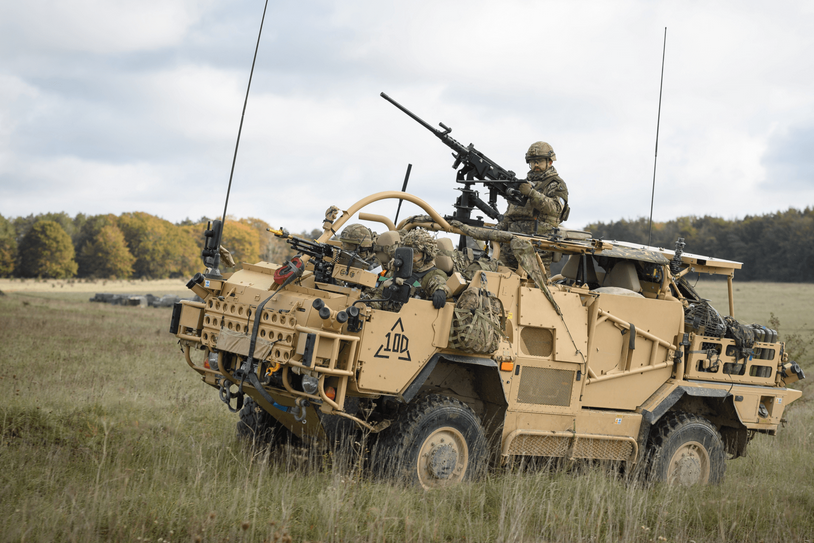
Jackal Reconnaissance Vehicle
The QOY are equipped with Jackal reconnaissance vehicles, armed with 7.62mm General Purpose Machine Guns and 12.7mm Heavy Machine Guns. The Wigan squadron are affiliated to ‘B’ Squadron Light Dragoons, a regular Royal Armoured Corps regiment. After over 200 years the DLOY name still lives on under the guardianship of ‘B’ (Duke of Lancaster’s Own Yeomanry) Squadron, Queens Own Yeomanry, based in Canal Street, off Woodhouse Lane in Wigan.
Graham Taylor 2022
Acknowledgment
Photographs courtesy of Lt. Col. (Rtd) J. Tustin, DLOY Museum Archive
Main Source
Chain Mail, The History of the Duke of Lancaster's Own Yeomanry by John Brereton
Other Sources
British Newspaper Archives
History of Parliament Online
The Archives of the Duke of Lancaster's Own Yeomanry
Wigan World website
Wikipedia